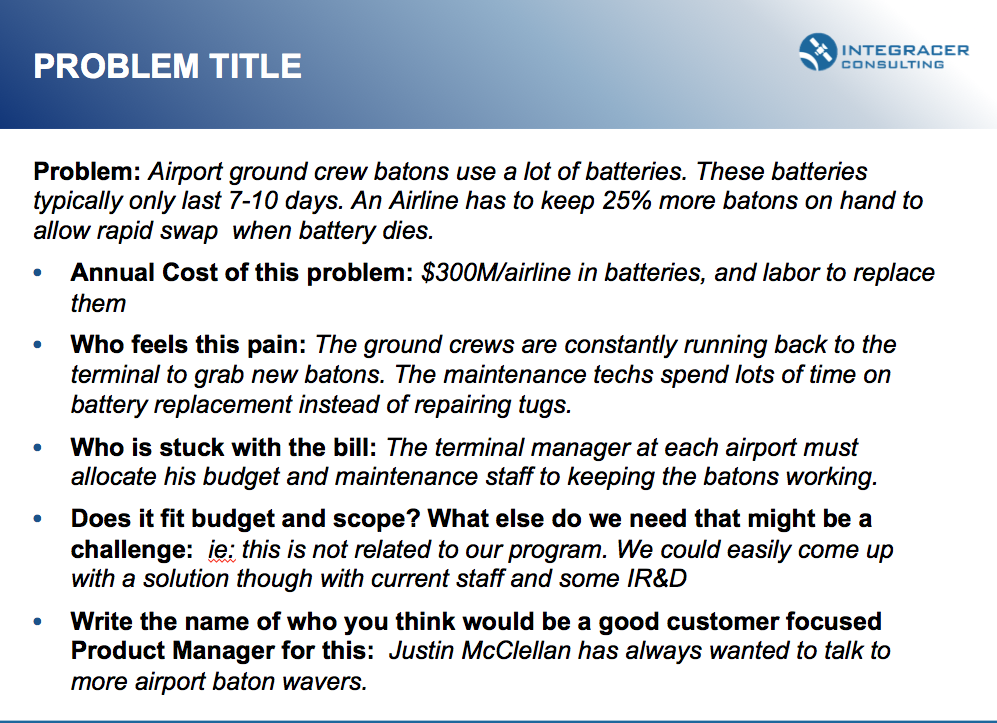As I stated in my first post on technology business development and commercialization, no one likes change. That includes buying, implementing, and adjusting to your product or service. People are busy and will not prioritize learning about your offering and deciding to proceed with a purchase. To ensure rapid adoption (or any adoption for that matter), you need to identify a problem or major pain point you can address for your customer.
Don’t focus on technology yet! Sure there is some foundation in technology or your expertise that might limit the scope of your brainstorming but it should not be the primary focus yet.
The task here is to define a dozen possible problem opportunities in 2-3 sentences
If you need multiple sentences to describe the problem, it is too complex and needs to be boiled down. You will want to come up with multiple problem opportunities so you can down-select later. Have everyone on your team come up with a few. For each we also want to think about the following, at least on the surface:
How big is the problem? Is it compelling enough to solve? Can you put a dollar value on the problem size?
Who feels the pain of this problem? Who is stuck with the bill? Don’t say “FedEx”. Be specific: “The pilots of FedEx Cessna Caravans flying in bad weather”. Who really pays for it, who’s budget? “FedEx’s VP of Operations and Regional Operations Managers.”
Can you implement a viable solution? Do you have the money to solve the problem or is it a $1B fix? Does it fit with your background, strengths, technology foundation? Do you have the skill sets on your team or in your network to solve the problem?
Are you passionate about this problem/opportunity? Do you want to be customer focused, interviewing customers and developing requirements to drive the product to meet their needs?
You should be able to put together a 1-pager or slide for each problem you identify. Here is a sample to try to help those poor guys marshaling aircraft on the tarmac waving lighted wands/batons:
Problem Evaluation Meeting
I typically will give my team the problem identification task as homework in preparation for a problem evaluation meeting. The team brings their problem 1-pagers to the meeting for the rest of the team to iterate and vote on. Given that there is a lot to discuss, I find that using a Post-Up ideation process can streamline this meeting.
During the meeting, the problems are presented by each member of the team. Questions can be asked and comments suggested but nothing should be negative. A negative comments typically ends a discussion stifling ideation. A positive comments leads to another comment, and another, etc.
The outcome of this meeting should be the following:
- The top 2-3 problem opportunities are down-selected.
- Each problem has a product manager[1] assigned to execute a deeper dive into the opportunity.
- Each problem has a few customers identified that can be called to further research the problem.
With the problem opportunities down-selected we now move on to refining the problems through customer surveys.
[1] In my opinion, the product manager is the key to successfully bringing a product or service to market. This person:
- Surveys customers to understand what they value, their decision making process.
- Is the voice of the customer to the engineers.
- Does pre-selling – sets up early demos and trials for customer feedback.
- Has confidence and passion – they will be selling the vision to customers, investors, team members.
- Adaptability – their focus is on delivering value to the customer, bringing the right technology to bear. They interact with customers and engineers spanning technical and sales roles.
